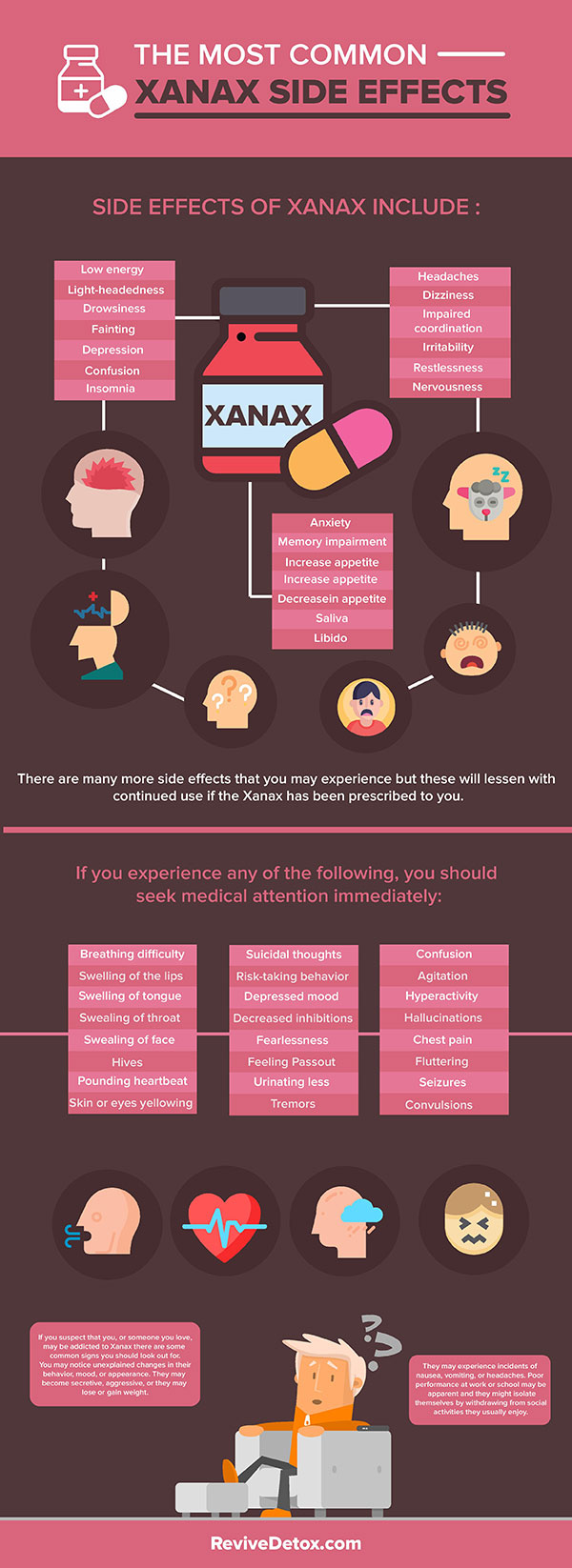Xanax is one of the most commonly abused prescription medications in the U.S. and Xanax addiction is more common than many people realize. On this page, we discuss the symptoms, side effects, and possible treatment for Xanax withdrawal.
What is Xanax and What Does a Xanax High Feel like?
Xanax is a brand name for the benzodiazepine, alprazolam. It’s commonly prescribed to people with a diagnosis of panic disorder or anxiety.
Xanax increases the amount of gamma-aminobutyric acid (GABA) which is a neurotransmitter that naturally occurs in the brain. This produces a calm and relaxed feeling.
Unlike drugs such as cocaine or heroin, Xanax does not produce feelings of euphoria, but instead makes the user feel quiet and relaxed. Often, the dug will tire people and they will fall asleep or pass out after taking it.
What Are the Most Common Xanax Side Effects?

These include:
- Low energy, drowsiness, light-headedness, or fainting
- Depression, confusion, insomnia, and/or nervousness
- Headaches, dizziness, impaired coordination
- Irritability, restlessness, anxiety, and memory impairment
- Increase or decreasein appetite, saliva, or libido
There are many more side effects that you may experience but these will lessen with continued use if the Xanax has been prescribed to you.
If you experience any of the following, you should seek medical attention immediately:
- Hives, breathing difficulty, swelling of the lips, tongue, throat or face
- Suicidal thoughts, risk-taking behavior, depressed mood, decreased inhibitions, and fearlessness
- Feeling thatyou may pass out
- Confusion, agitation, hyperactivity, hallucinations
- Chest painor fluttering, pounding heartbeat, and skin or eyes yellowing
- Urinating less than normal or not at all.
- Tremors, seizures, convulsions, or uncontrolled muscle movements
What Are the Most Common Xanax Addiction Symptoms?
If you suspect that you, or someone you love, may be addicted to Xanax there are some common signs you should look out for.
You may notice unexplained changes in their behavior, mood, or appearance. They may become secretive, aggressive, or they may lose or gain weight.
Your loved one may seem to be sleeping a lot and appear sluggish when they’re awake. They may experience incidents of nausea, vomiting, or headaches.
Poor performance at work or school may be apparent and they might isolate themselves by withdrawing from social activities they usually enjoy.
Financial or relationship problems may occur and often they will not be able to explain why they are experiencing difficulties.
Common Symptoms of Xanax Withdrawal
Often, people who are addicted to Xanax and other benzodiazepines are unaware of it, until they begin to experience withdrawal symptoms. Some of the other common symptoms include wanting to use the drug more often, difficulty focusing on anything else, and needing to use more of the drug to achieve the same effect as previous use.
You may experience feelings of panic if you’re not able to get Xanax immediately and you may find that you take more of the drug in a sitting than you originally intended. You may even have tried to stop taking the drug but found you couldn’t.
A person with an addiction will use their drug of choice regardless of any negative consequences such as loss of relationships, money or health. They may engage in risky behaviors to obtain Xanax or while under the influence of Xanax. Obtaining and using Xanax will take up most of the person’s time and energy.
Does Snorting Xanax Always Lead to Xanax Addiction?
Many people believe that crushing Xanax tablets and snorting the powder leads to a quicker or more intense high. However, this is not true. Snorting Xanax can lead to damage in your sinuses, nasal passages, and airway.
Snorting Xanax may lead to abuse of other drugs such as cocaine. This can also be a result of not getting the high from Xanax that was expected.
What Are the Symptoms of Xanax Withdrawal from Xanax Pills?
Withdrawal from any drug can be an unpleasant experience and Xanax is not an exception. Withdrawal symptoms can be physical, psychological, or both. Xanax has a short half-life which means it is absorbed into the body and then removed by your system quite quickly.
Cold turkey withdrawal can produce some severe symptoms and we recommend that you withdraw under medical supervision.
The physical symptoms can include seizures, which can in rare cases, be fatal – which is why medical supervision is recommended. Other symptoms can include excessive sweating, hand tremors, sore of stiff muscles, spasms, and twitching.
Nausea and vomiting may occur and also diarrhea or soft stools. Headaches are common, as is menstrual bleeding in women, and weight gain or loss. Heart palpitations or tachycardia may also occur.
The psychological effects of withdrawal can be just as unpleasant as the physical and should not be taken lightly. These may include, nervousness, tension, insomnia, restless sleep, and irritability. Anxiety and panic may also be present.
Depression, paranoia, fear, and confusion are also common symptoms of Xanax withdrawal. If you are experiencing any suicidal thoughts or chest pain, you should seek professional advice or visit an ER immediately.
What Is the Recommended Treatment for Xanax Addiction?
All treatment needs to start with detoxification and this should be conducted under the supervision of registered medical professionals.
At Revive Detox, our clinical team are registered nurses and emergency medical technicians who work alongside our Doctors and Psychiatrists.Contact us today, 24/7 to discuss your recovery needs and options.Most PPO Health








